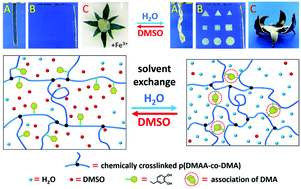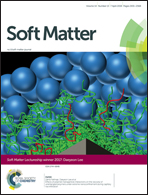Super strong dopamine hydrogels with shape memory and bioinspired actuating behaviours modulated by solvent exchange†
Abstract
Dopamine-containing hydrogels were synthesized by copolymerization of dopamine methacrylamide (DMA), N,N-dimethylacrylamide (DMAA), and an N,N′-methylenebisacrylamide (BIS) crosslinker in a mixed solvent of water and DMSO. The association of DMA was formed by simply immersing in water to facilely reinforce the hydrogel due to the introduction of the second physical crosslinking. The tensile strength of the hydrogels was increased greatly and regulated in a wide range from 200 kPa to over 2 MPa. The association of DMA was destroyed upon immersing in DMSO. This reversible formation and dissociation of the association structure endowed the hydrogel with shape memory and actuating capabilities. Rapid shape fixing in water and complete shape recovery in DMSO was realized within several minutes. Bioinspired functional soft actuators were designed based on the reversible association and metal ion coordination of DMA, including fast responsive hydrogel tentacles, programable multiple shape change, reversible and versatile painting and writing “hydrogel paper”. The facile preparation and strength regulation provide a new way to design novel soft actuators through solvent exchange, and will inspire more complex applications upon combining the association with other properties of mussel inspired dopamine derivatives.



 Please wait while we load your content...
Please wait while we load your content...